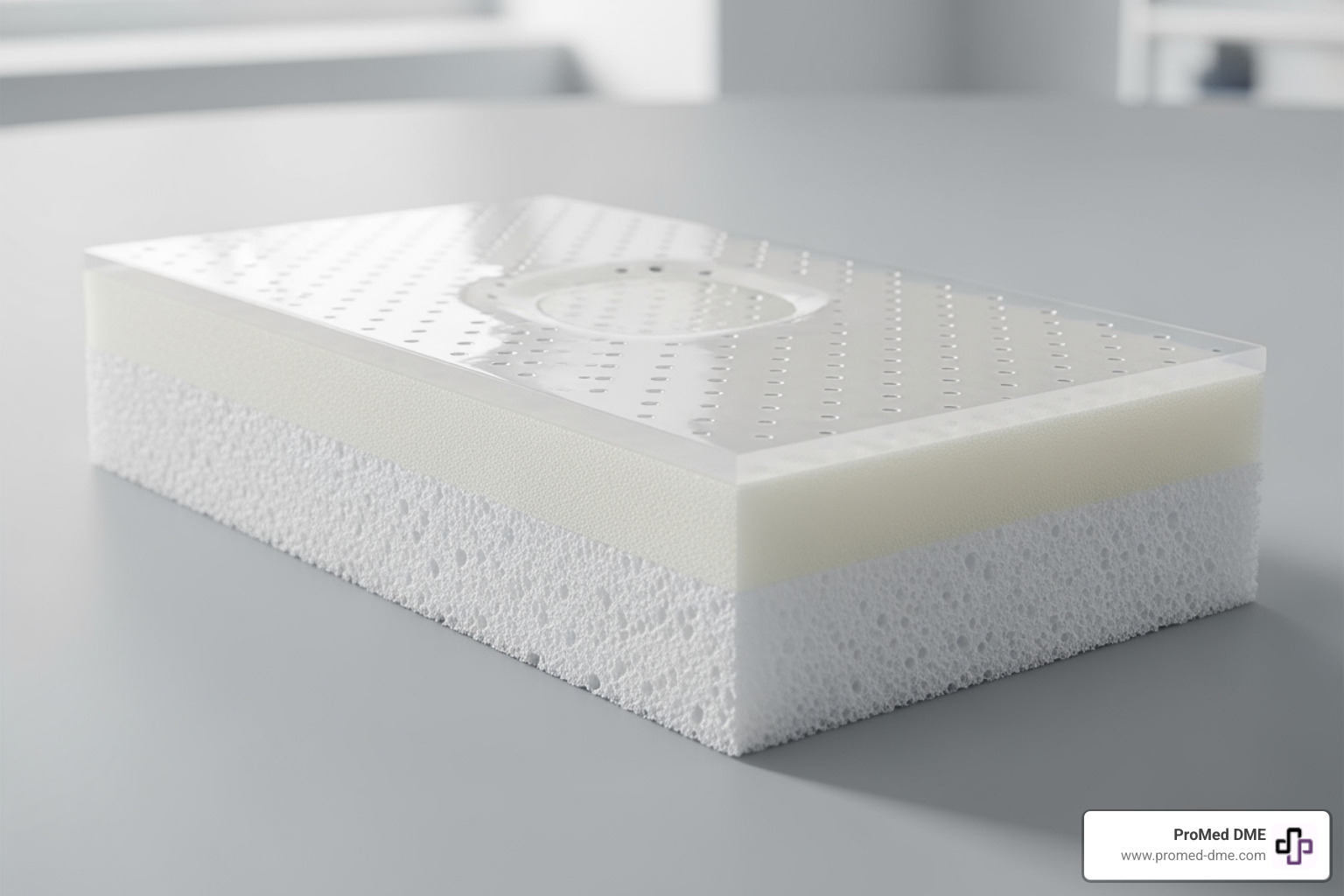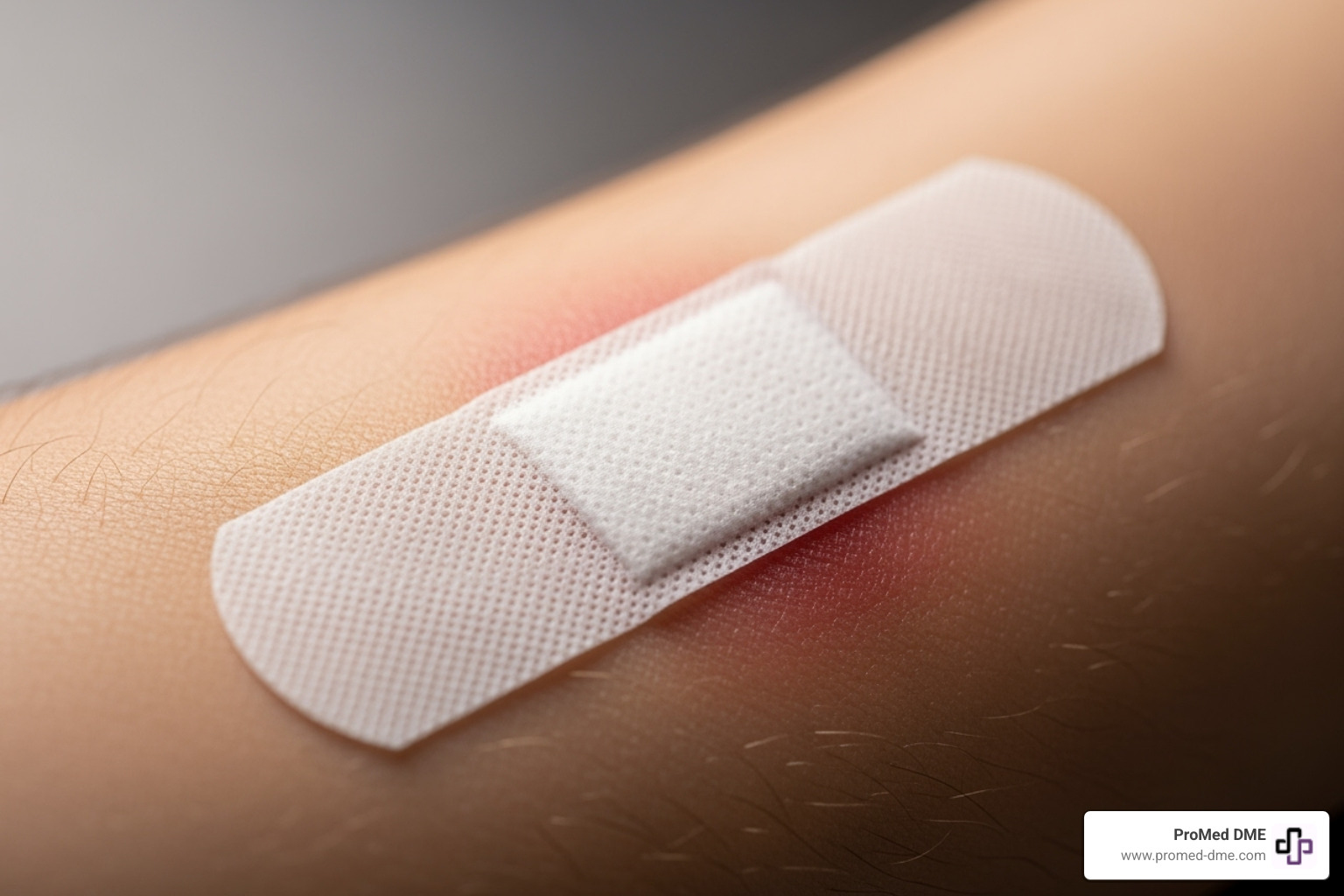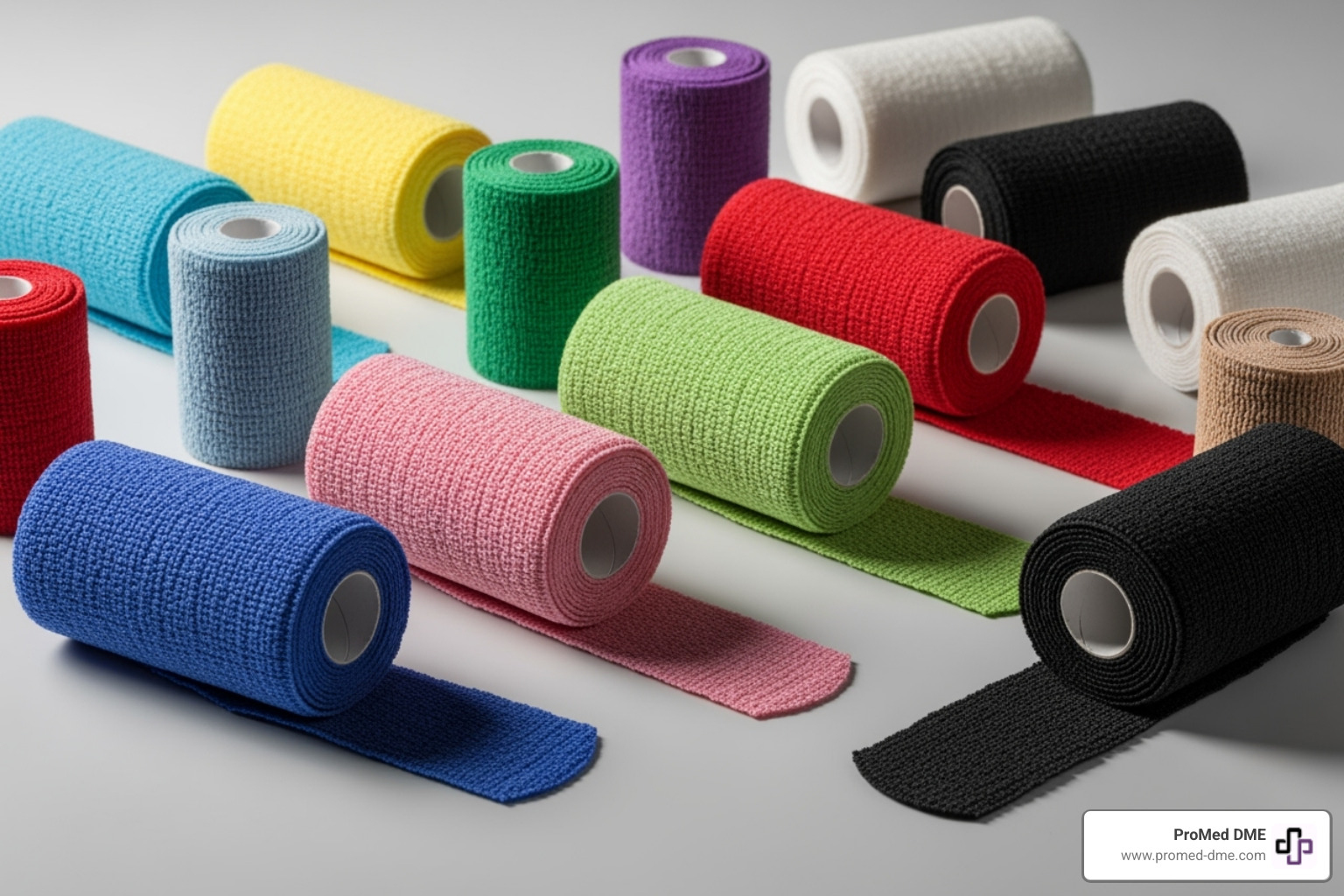Blister Breakthrough: How Hydrocolloid Bandages Work Wonders
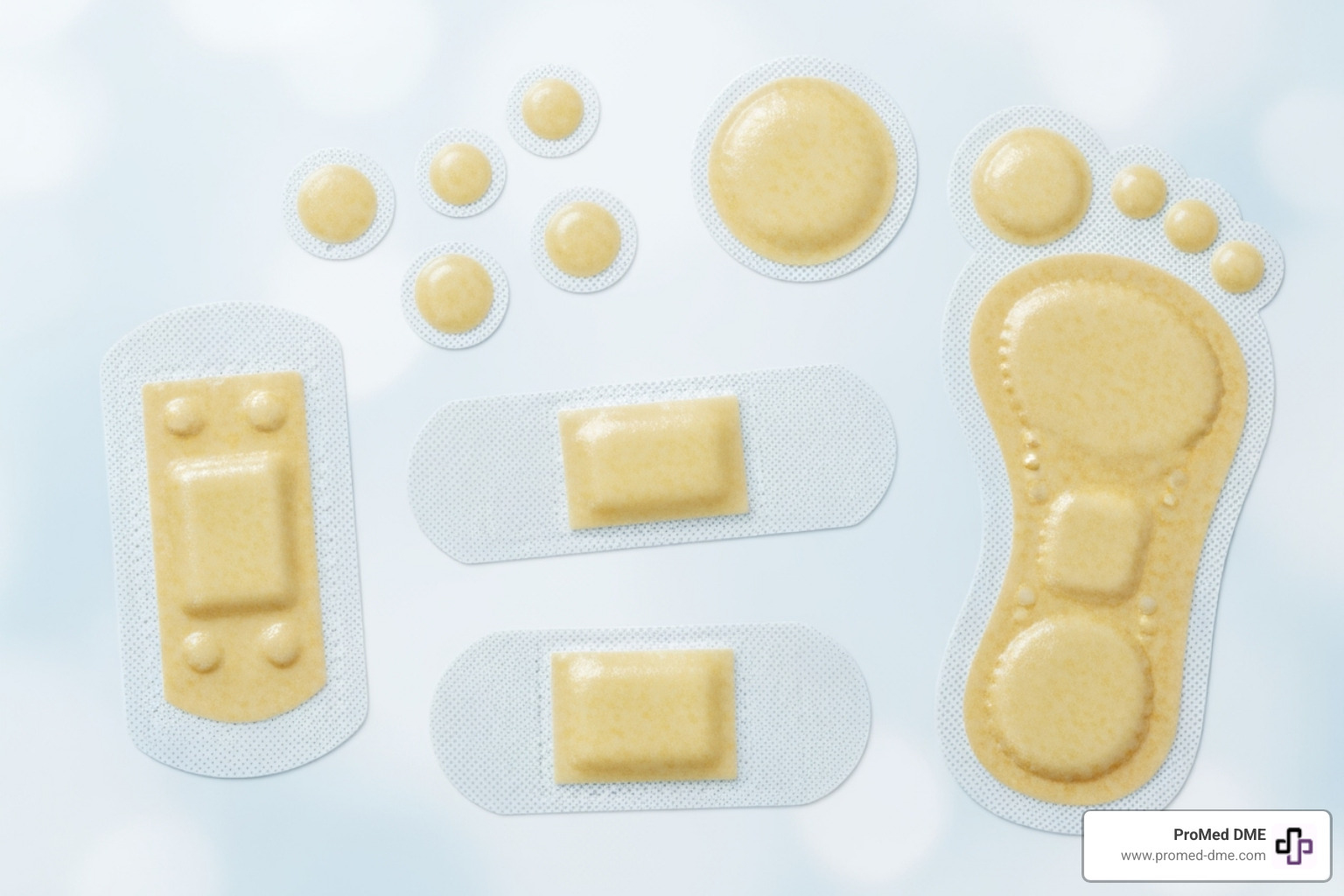
Why Hydrocolloid Blister Bandages Are Revolutionary for Wound Care
Hydrocolloid blister bandages are advanced wound dressings that create a moist healing environment by absorbing fluid from blisters and forming a protective gel cushion. Unlike traditional bandages, they stay in place for 3-7 days and provide superior pain relief while preventing infection.
Key Features of Hydrocolloid Blister Bandages:
- Gel-forming technology - Absorbs wound fluid and creates protective cushioning
- Waterproof seal - Stays on through showers and daily activities
- Extended wear time - Lasts 3-7 days versus daily changes with regular bandages
- Visual healing indicator - Forms a white bubble to show healing progress
- Superior comfort - Reduces pain and prevents scabbing
Whether you're dealing with painful foot blisters from new shoes, managing chronic wounds, or seeking better healing outcomes, understanding how these innovative bandages work can transform your wound care experience.
The magic happens through hydrocolloid materials like sodium carboxymethyl cellulose and gelatin that turn wound fluids into a healing gel. This creates what medical professionals call a "moist wound environment" - the gold standard for faster, more comfortable healing.
As one user shared in online forums, regular hydrocolloid bandages worked "WAY better" than any specialized patch they had tried, highlighting how this proven technology delivers real results for everyday wound care needs.
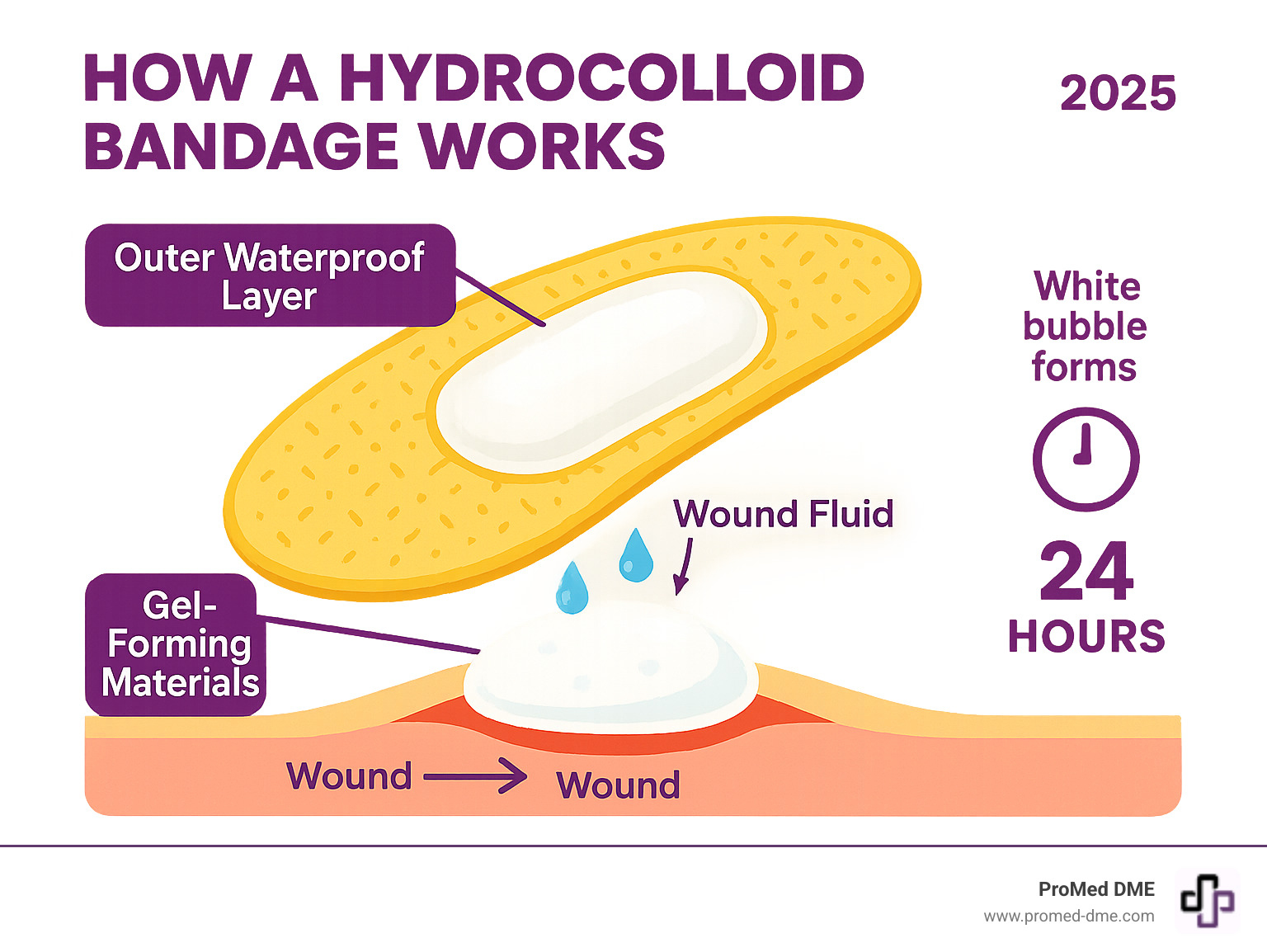
What Are Hydrocolloid Bandages and How Do They Work?
Think of hydrocolloid blister bandages as your skin's personal healing assistant. While regular bandages just sit there covering wounds, these smart dressings actually get to work creating the perfect environment for your body to heal itself.
The design is brilliantly simple yet sophisticated. Each bandage has two main layers working together like a well-coordinated team. The outer layer is made from a waterproof polyurethane film that acts like a protective shield. This isn't your typical bandage material that falls off the moment it gets wet. This waterproof seal keeps bacteria, dirt, and moisture out while still letting your skin breathe.
But here's where things get really interesting. The inner layer contains special hydrocolloid materials that spring into action the moment they meet wound exudate - that's the natural fluid your body produces when you have a blister or cut.
When these materials absorb the fluid, something almost magical happens. They transform into a soft, cushiony gel that forms a protective barrier right over your wound. This gel cushion does triple duty: it keeps the wound moist for faster healing, prevents the bandage from sticking to tender new skin, and creates a comfortable buffer against bumps and friction.
Within about 24 hours, you'll notice a white bubble forming under the bandage. Don't panic - this is actually great news! That white bubble is your healing progress report, showing that the bandage is actively absorbing fluids and doing its job. It's like having a little window into your body's repair work.
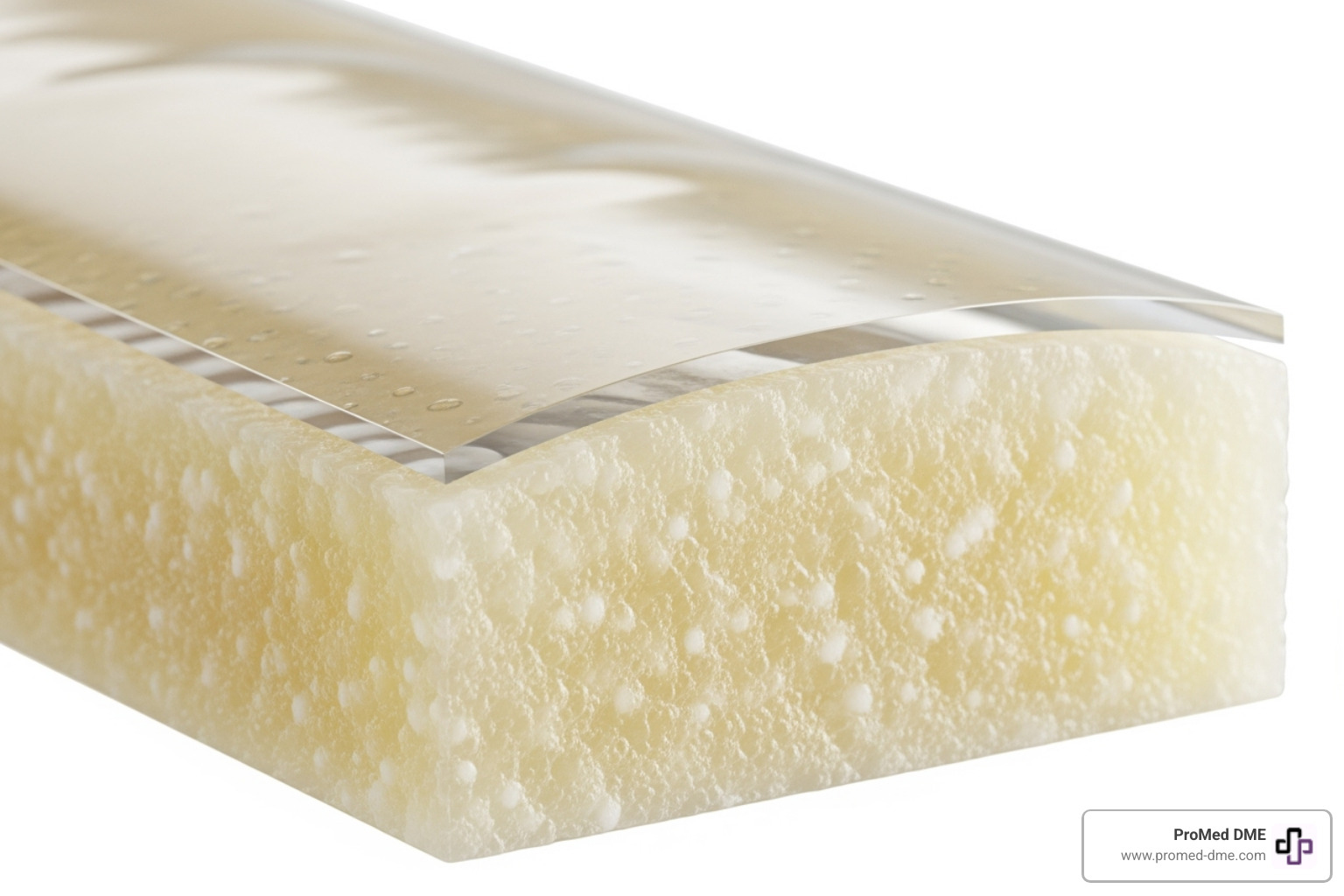
The Science Inside the Bandage
So what exactly makes these hydrocolloid blister bandages so special? The secret lies in three key ingredients that work together like a perfectly balanced recipe.
Sodium carboxymethyl cellulose is the star player here. This super-absorbent material soaks up wound fluid like a tiny sponge and transforms it into a protective gel. You might not realize it, but this same ingredient helps thicken ice cream and keeps toothpaste smooth - it's that versatile!
Gelatin brings more to the table than just helping form that healing gel. Beyond its familiar role in desserts, medical-grade gelatin actually supports your body's natural clotting process and encourages healthy tissue growth. Pretty impressive for something you might have in your kitchen cupboard.
Pectin rounds out this healing trio. Yes, it's the same stuff that makes your homemade jam set properly. In bandages, pectin boosts the absorbent properties and helps create that cohesive, protective gel layer.
These three ingredients create what wound care experts call a moist environment - and that's the gold standard for healing. Your cells can move around more easily, damaged tissue breaks down naturally, and new healthy skin forms faster. It's a complete turnaround from the old "let it air dry" approach that actually slows healing down.
The beauty of this system is that it mimics what your body wants to do naturally, just with a little high-tech help to make everything work better and more comfortably.
Hydrocolloid vs. Traditional Bandages: A Clear Winner for Blisters
Let's be honest – most of us have slapped a regular bandage on a blister and called it good. But here's the thing: hydrocolloid blister bandages aren't just a fancy upgrade. They're actually a completely different approach to healing that makes traditional bandages look pretty outdated.
Think about what happens with a regular fabric bandage on a blister. You stick it on, it gets wet in the shower, starts peeling at the edges, and by the end of the day you're dealing with a soggy mess that's lost most of its stickiness. Sound familiar?
Hydrocolloid blister bandages flip this whole experience on its head. The moment you apply one, you'll notice the superior cushioning effect. That painful pressure from your shoe rubbing against the blister? Gone. The gel-forming layer creates a protective buffer that actually absorbs impact, making walking comfortable again.
But the real magic happens over time. While traditional bandages need daily changes (or more if they get wet), hydrocolloid blister bandages create their own little healing environment and stay put for 3 to 7 days. No daily bandage changes means no daily pain from peeling off stuck fabric.
The waterproof seal is another game-changer. You can shower, wash dishes, even go swimming, and the bandage stays perfectly in place. Try that with a regular bandage – you'll end up with wet, peeling edges and exposed skin.
Here's what really sets them apart: scar prevention. Traditional bandages often lead to scabbing, which can slow healing and leave more noticeable marks. Hydrocolloid blister bandages maintain that crucial moist environment that prevents scabs from forming. Your skin heals faster and looks better afterward.
The infection barrier protection is also notably stronger. That secure, sealed edge prevents bacteria from sneaking in – something loose or wet traditional bandages struggle with.
| Feature | Hydrocolloid Blister Bandages | Traditional Fabric Bandages |
|---|---|---|
| Healing Env. | Moist, promotes faster healing, prevents scabs | Dry, can lead to scabbing, slower healing |
| Waterproofing | 100% waterproof, stays on through showers | Generally not waterproof, peels when wet |
| Wear Time | 3 to 7 days (or until white bubble reaches edge) | Daily changes, or more often if wet/dirty |
| Pain Relief | Excellent cushioning, reduces pressure and friction | Limited cushioning, basic physical barrier |
| Infection Barrier | Strong, sealed barrier against bacteria | Weaker barrier, prone to contamination |
| Scar Prevention | Promotes minimal scarring by preventing scabs | Can contribute to more noticeable scarring |
| Flexibility | Conforms to skin, allows natural movement | Can be stiff, may restrict movement |
The flexibility factor matters more than you might think. These bandages move with your skin instead of fighting against it. No more stiff, crinkly feeling when you bend your finger or flex your foot.
It's not just about convenience – it's about giving your body the best possible conditions to heal itself properly.
A Practical Guide to Using Hydrocolloid Blister Bandages
Getting the most out of hydrocolloid blister bandages isn't rocket science, but a few key techniques can make all the difference between a bandage that works wonderfully and one that falls off after a day. Think of it like following a recipe – the ingredients are great, but the method matters too.
The good news? These bandages are designed to be user-friendly. They work best on what medical folks call "deroofed" blisters – those painful ones where the top layer of skin has already popped or peeled away, leaving that raw, weeping surface underneath. If you've ever dealt with a nasty blister from new hiking boots or dress shoes, you know exactly what we're talking about.
Athletes and hikers particularly love these bandages because they can handle the constant movement and moisture that comes with active lifestyles. Unlike regular bandages that might slip or bunch up during a long run, hydrocolloid blister bandages stay put and actually get better at their job as they absorb fluid and form that protective gel cushion.
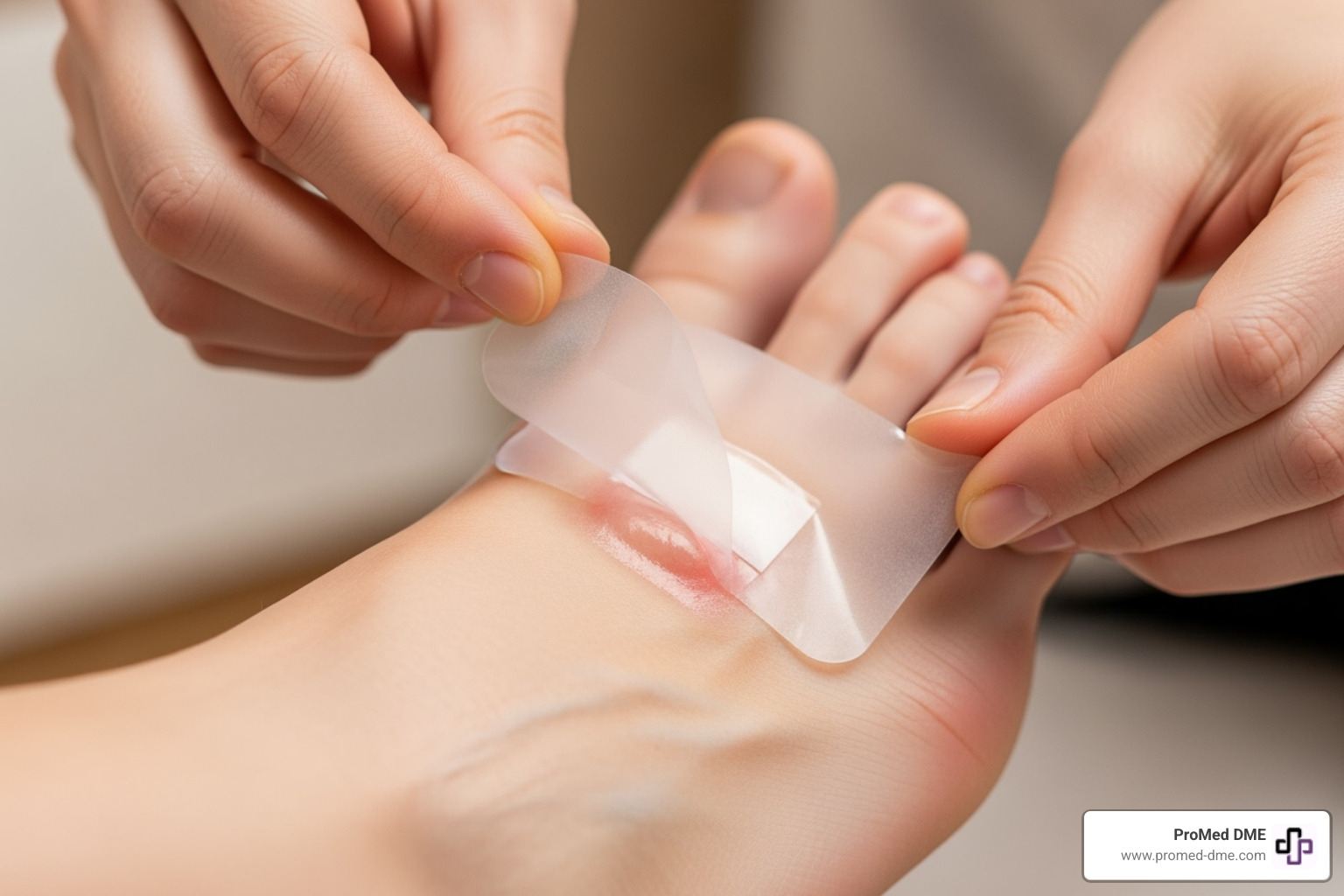
Proper Application of hydrocolloid blister bandages
The secret to success starts before you even open the package. Clean the wound gently with mild soap and water – nothing fancy needed. Just get rid of any dirt or debris that might interfere with healing. Then comes the crucial step that many people skip: dry the skin completely. We can't stress this enough. These bandages are like that friend who needs a completely clean, dry surface to really stick around for the long haul.
Proper sizing makes a huge difference too. You want a bandage that covers your blister with some room to spare around the edges. Think of it as giving the bandage enough real estate to create a good seal. While you might be tempted to cut a large bandage down to size, resist that urge for blisters. The margin around the wound isn't wasted space – it's your insurance policy for proper adhesion and absorption.
When you're ready to apply the bandage, peel off that backing carefully without touching the sticky side. Nobody wants fingerprints on their medical equipment! Position it directly over the blister, then comes the satisfying part: smoothing those edges from the center outward. You're creating a waterproof seal that would make a submarine jealous.
Here's a pro tip that might save you some frustration: avoid moisturizing the area before application. We know it seems counterintuitive when your skin feels dry and irritated, but lotions and creams are the enemy of good adhesion. Save the moisturizer for after the healing is complete.
When to Use and When to Avoid hydrocolloid blister bandages
Hydrocolloid blister bandages shine brightest on deroofed blisters where they can absorb fluid and create that healing environment. They're also fantastic for minor abrasions – those everyday scrapes and superficial wounds that seem to happen when you least expect them. Many people don't realize they work well on superficial burns too, though anything more serious than a minor kitchen mishap should get professional attention.
Here's where things get interesting: these versatile bandages have found a second life treating superficial acne. When you've got a pimple that's come to a head or has already been popped (we won't judge), a small piece can work wonders to absorb fluid and prevent scarring.
But like any good tool, they have their limits. Never use them on intact blisters where the skin is still covering the fluid underneath. The adhesive is strong enough that removing it could tear off that protective skin layer, turning a manageable blister into a painful open wound.
Infected wounds are another absolute no-go. If you see redness spreading beyond the wound, notice pus, smell something funky, or feel increasing pain, step away from the bandage and call your healthcare provider. The same sealed environment that promotes healing can trap bacteria if infection has already set in.
Deep wounds, heavily bleeding injuries, and anything that looks like it might need stitches require professional medical care, not a DIY bandage solution. And if you've ever had an allergic reaction to adhesive bandages before, test a small area first or consult with your doctor.
A 2014 systematic research review on dressing effectiveness found that while hydrocolloid dressings weren't necessarily superior to other advanced dressings for all wound types, they excelled at maintaining moisture, controlling drainage, reducing pain, and providing an excellent barrier – exactly what you want for blister care.
The bottom line? Hydrocolloid blister bandages are incredibly effective when used correctly on the right type of wound. Master the application technique, understand when they're appropriate, and you'll wonder how you ever managed blister care without them.
Potential Risks and Other Uses
Let's be honest - hydrocolloid blister bandages are pretty amazing, but they're not magic. Like any medical product, they come with a few things to watch out for, plus some surprisingly handy alternative uses that might just blow your mind.
Most people use these bandages without any problems at all. But occasionally, some folks might experience skin irritation around the edges where the adhesive sits. This is more likely if you have particularly sensitive skin or leave the bandage on longer than recommended. It's usually just mild redness that goes away quickly after removal.
Even rarer is an allergic reaction to one of the bandage components. Most hydrocolloid blister bandages are designed to be hypoallergenic and latex-free, but everyone's skin is different. If you notice increased itching, a rash spreading beyond the bandage area, or any other unusual reaction, remove it right away and give your doctor a call.
Here's something that catches people off guard: when you remove a hydrocolloid bandage, there might be a slightly funky smell. Don't panic! This is totally normal and comes from the absorbed wound fluid mixing with the gel. It doesn't mean you have an infection - just check that the wound itself looks healthy and healing properly.
The one risk that's worth taking seriously is trapped bacteria. This only becomes a problem if you apply the bandage to an already infected wound. These bandages create a sealed environment, which can make bacterial infections worse. That's why we always emphasize using them only on clean, non-infected wounds.
Can Hydrocolloid Bandages Be Used for Acne?
Here's where things get really interesting! Hydrocolloid blister bandages have become the secret weapon of skincare enthusiasts everywhere. They work on pimples using the exact same principle as they do on blisters - absorbing fluid and creating a protective healing environment.
When you slap one of these on a pimple that's come to a head (you know, the ones with visible pus or fluid), the hydrocolloid material gets to work immediately. It draws out that fluid, which reduces inflammation and makes the blemish way less angry-looking. Plus, it creates a physical barrier that stops you from picking at it - and we all know how hard that can be to resist!
Many people have finded that regular hydrocolloid blister bandages can be cut into smaller pieces to create DIY pimple patches. Online forums are full of users raving about how generic blister bandages work "WAY better" than expensive specialized acne patches and cost a fraction of the price.
The best candidates for this treatment are superficial acne spots - think whiteheads or pimples with a clear head. Apply one overnight, and you'll often wake up to a significantly calmer, less noticeable blemish. It's like having a tiny healing factory working while you sleep.
But here's an important heads-up: stay away from cystic acne with these bandages. Those deep, painful cysts don't have fluid near the surface that hydrocolloids can reach. Using them on cystic acne won't help and might actually irritate your skin further. For those stubborn deep cysts, a dermatologist is your best bet.
The beauty of using hydrocolloid blister bandages for minor burns and other small wounds is that you're getting the same professional-grade healing technology that medical professionals rely on. Whether you're dealing with a kitchen mishap or helping your kid with a scraped knee, you're providing optimal healing conditions that promote faster, more comfortable recovery.
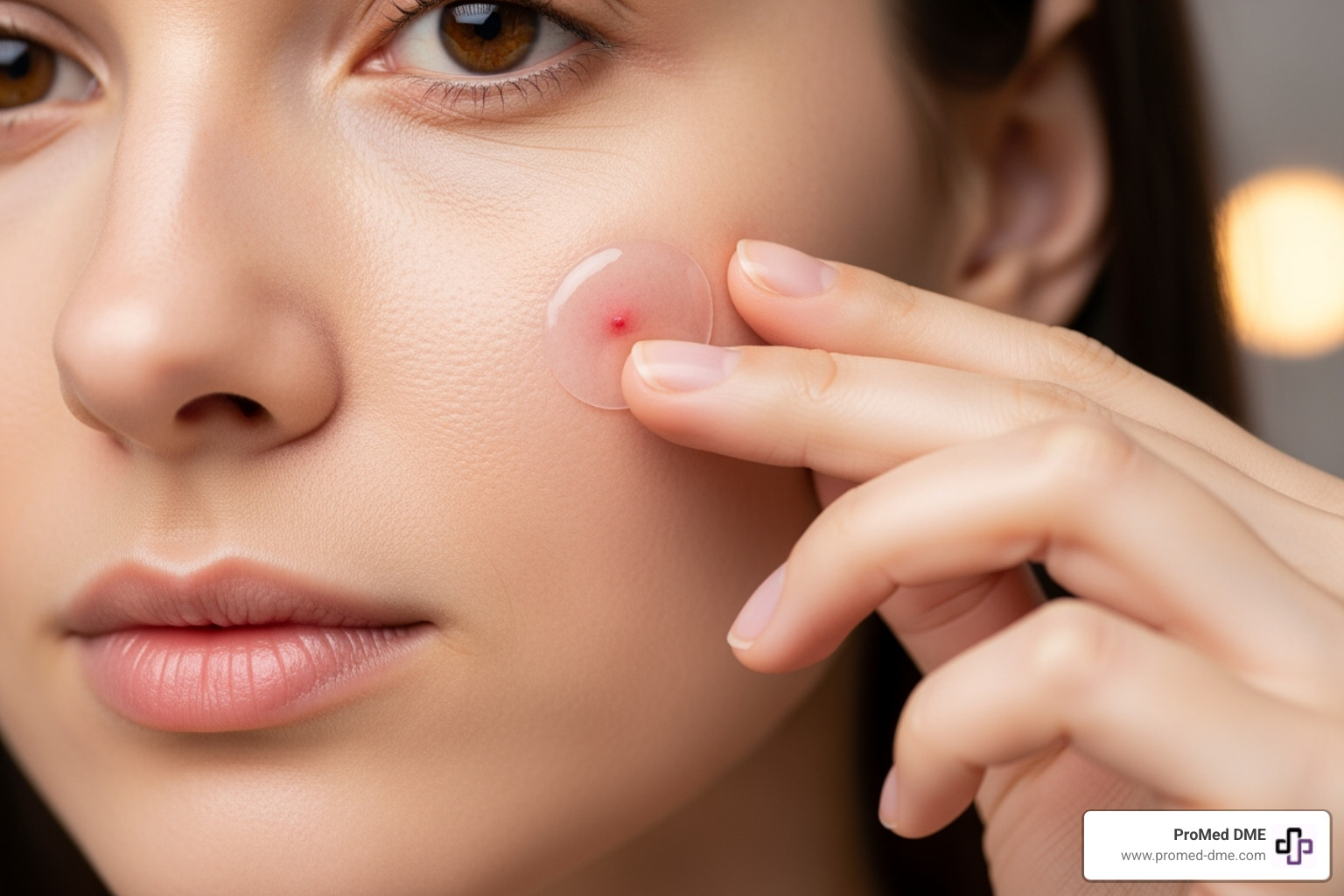
Frequently Asked Questions about Blister Care
When you're dealing with painful blisters, it's natural to have questions about how hydrocolloid blister bandages work and what to expect during the healing process. Let's address the most common concerns we hear from people trying these innovative bandages for the first time.
How long can a hydrocolloid bandage stay on?
Here's one of the biggest advantages of hydrocolloid blister bandages – they're designed for the long haul. Unlike regular bandages that need daily changes, these can stay put for 3 to 7 days straight. That means no painful daily peeling and re-sticking, which is especially welcome when you're dealing with tender, healing skin.
The exact duration depends on how much fluid your blister produces and how well the bandage maintains its seal. Think of it like a sponge – eventually, it reaches its capacity. You'll know it's time for a change when the white bubble reaches the edge of the bandage, signaling it's absorbed all it can.
Other signs it's time for a fresh bandage include peeling edges that compromise the waterproof seal, or any leaking fluid from underneath. If you notice increased redness, swelling, or any signs of infection, remove the bandage immediately and consult a healthcare professional.
The beauty is that as long as the bandage stays sealed and the white bubble hasn't spread to the edges, you can confidently leave it alone to do its healing work.
What does the white bubble under the bandage mean?
Don't panic when you see that white, cloudy bubble forming under your bandage – it's actually a healing indicator that shows everything is working perfectly! This white formation is the visual proof that your hydrocolloid blister bandage is actively absorbing fluid from your wound.
Here's what's happening: the hydrocolloid materials inside the bandage are soaking up the wound exudate (that's the medical term for the fluid that naturally seeps from healing tissue). As they absorb this fluid, they transform into a soft, protective gel cushion right over your wound. This gel appears white or cloudy through the bandage's transparent outer layer.
This absorbed fluid and resulting gel formation creates the ideal moist environment for healing while providing cushioning against further friction or pressure. It's like having a custom-made protective pillow for your wound. So when you see that white bubble, you're literally watching the normal healing process in action.
Should I pop a blister before applying a hydrocolloid bandage?
This is probably the most important question we get, and the answer might surprise you: leave intact blisters alone. If your blister hasn't burst on its own, that intact skin roof is actually your body's natural barrier against infection. It's sterile, protective, and doing exactly what nature intended.
Hydrocolloid blister bandages work best on deroofed blisters – those that have already burst or had their top layer removed. When a blister is open and weeping, that's when these bandages shine by absorbing the fluid and creating their protective gel cushion.
Popping an intact blister yourself significantly increases your infection risk. You're essentially creating an open wound in a non-sterile environment. If you have a large or particularly painful intact blister, it's worth consulting a healthcare professional who can safely drain it using proper sterile techniques.
Once you have a deroofed blister, that's when hydrocolloid blister bandages become your best friend for comfortable, faster healing. For comprehensive guidance on proper wound care practices and when to seek professional help, you can find more information at ProMed DME.
Conclusion: Accept Faster, More Comfortable Healing
When you're dealing with painful blisters, you deserve better than the old-fashioned approach of dry bandages and daily changes. Hydrocolloid blister bandages have truly revolutionized how we think about wound care, changing what used to be a slow, uncomfortable process into something remarkably effective and gentle.
The science speaks for itself: moist healing environments promote faster tissue regeneration, while the protective gel cushion provides immediate pain reduction that makes walking bearable again. The superior protection against bacteria and contaminants means you can go about your daily routine - including showers - without worrying about infection or constant bandage changes.
Perhaps most importantly, these innovative dressings help your skin heal more naturally, preventing the thick scabs that can lead to permanent scarring. Instead, you get stronger, more resilient skin that looks and feels better in the long run.
At ProMed DME, we've seen how the right wound care supplies can transform someone's healing experience. That's why we're committed to bringing you these advanced solutions alongside the personal touch you deserve. Our dedicated nurse on staff is always available to answer your questions, and with free shipping across the United States, getting the care you need has never been easier.
Whether you're an athlete dealing with friction blisters, a hiker with foot problems, or simply someone who wants their wounds to heal properly, hydrocolloid blister bandages offer a proven path to better recovery. Why settle for outdated methods when you can accept faster, more comfortable healing?
Ready to experience the difference for yourself? Explore our complete range of advanced wound care products and find how proper wound care can change everything about your healing journey.
Related Resources & Articles
Stay informed with our informative blog posts.
Discover the ProMed Advantage
& Try Our Products
We offer free shipping and legendary customer service to ensure you receive the
best DME products for your needs.

